Figure 3.
Overexpression of SPARC and low-dose radiation suppresses NB1691 and SK-N-BE(2) VEGF-A expression. SPARC and VEGF-A expression from paraffin sections of NB1691 and SK-N-BE(2) tumors were quantified by ImageJ and represented as arbitrary pixel units. SPARC overexpression resulted in significant reduction of VEGF-A expression, radiation further decreased SPARC induced reduction of VEGF-A (control vs. SPARC and control vs. SPARC + radiation, *P<0.05, **P<0.001) (A). Semi-quantitative analysis showing increase of SPARC expression when treated with SPARC overexpressing plasmid (control vs. SPARC and control vs. SPARC + radiation **P<0.001) (B). Western blotting for VEGF-A and SPARC in NB1691 and SK-N-BE(2): subcutaneous tumors treated with SPARC overexpression plasmid with or without radiation showed decrease in levels of VEGF-A (C). Similarly, increased SPARC expression along with radiation greatly reduced the expression of VEGF-A in both SK-N-BE(2) and NB1691 cell lines (D). In vitro angiogenic inhibition by SPARC overexpression was compared to bevacizumab using endothelial cells cultured over Matrigel in NB1691 and SK-N-BE(2) conditioned media as indicated (E). Quantative analysis for angiogenic inhibition revealed that SPARC overexpression (OE) was comparable to bevacizumab treatments in both NB1691 (control vs. SPARC-OE #P=0.05, control vs. bevacizumab ##P=0.06, control vs. SPARC-OE radiated @P=0.02 and control vs. bevacizumab radiated *,@P=0.03) and SK-N-BE(2) (control vs. SPARC-OE *P=0.005, control vs. bevacizumab ##,*P=0.004, control vs. SPARC-OE radiated **,#P=0.004 and control vs. bevacizumab radiated *,##P=0.0002) cells (F).

